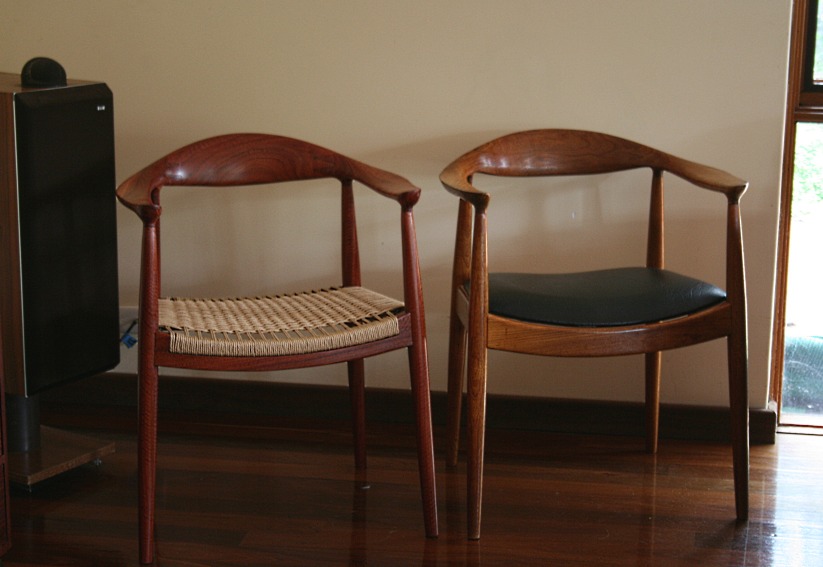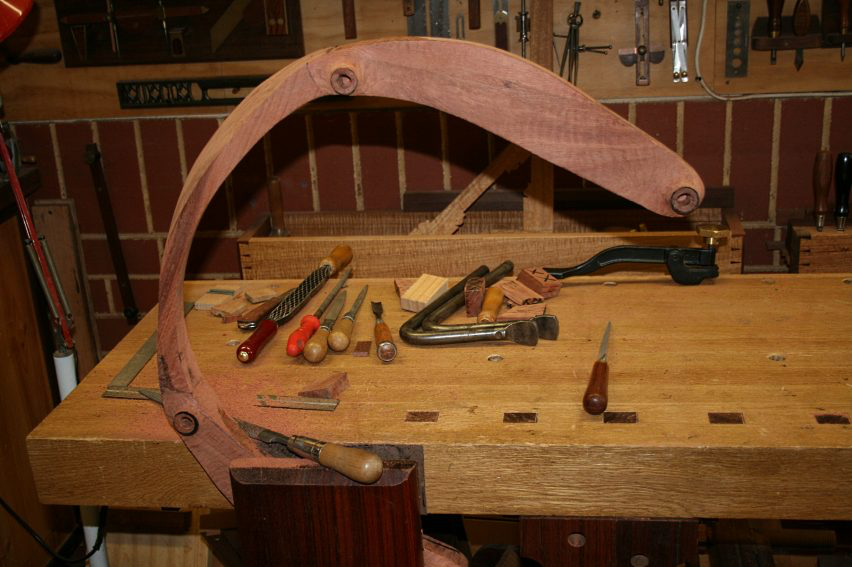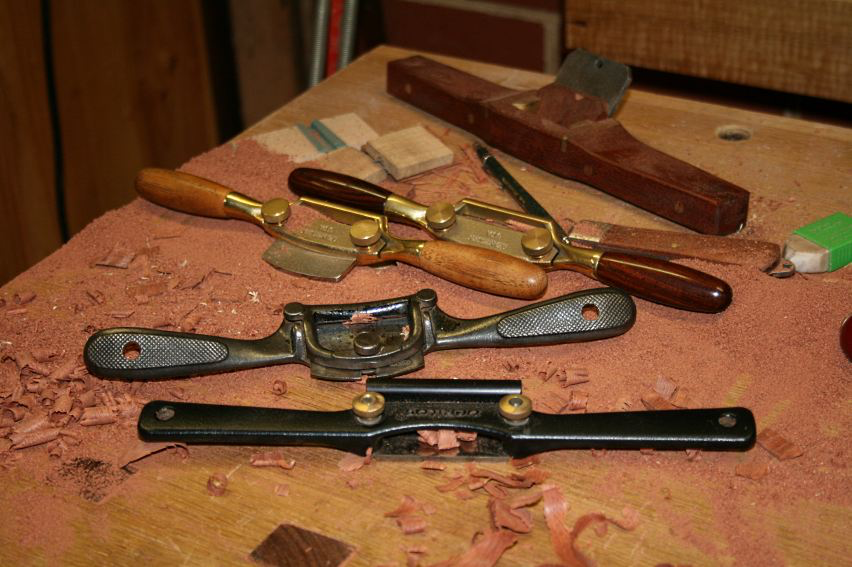 Needs Pictures: 0
Needs Pictures: 0
 Picture(s) thanks: 0
Picture(s) thanks: 0
Results 1 to 15 of 42
-
27th December 2023, 04:43 PM #1
 Shaping elliptical, curved chair legs
Shaping elliptical, curved chair legs
I am building dining room chairs (and a dining room table), and the chairs will be similar to the one below. It has been fun designing and dimensioning


The legs are both curved and have an elliptical profile. Because of this, they cannot be turned on a lathe. I have created a template, partly for marking out and partly a potential pattern for a router table.
Here is the "however" ... the wood is Rock Maple (or Hard Maple) and I have never routed this with pattern bits. I have read that it is not a good choice of wood for this method (tending to blow out and blow up at the suggestion of cutting into the grain).
When it comes to shaping, my preference is to use hand tools ... spokeshaves, etc. I have build a similar chair completely with hand tools in the past, an exact copy of Hans Wegner's "The Chair", even copying the mortice and tenon joinery with hand tools. This is a piece of furniture built in the factory with lathe copiers.
Mine on the left, original on the right ...


When it comes to the dining chair, you can see that I like the style
So ... shape the legs with spokeshaves, or what router bit and method can be suggested?
Regards from Perth
DerekVisit www.inthewoodshop.com for tutorials on constructing handtools, handtool reviews, and my trials and tribulations with furniture builds.
-
27th December 2023 04:43 PM # ADSGoogle Adsense Advertisement
- Join Date
- Always
- Location
- Advertising world
- Posts
- Many
-
27th December 2023, 04:58 PM #2

nickjamesdesign on Instagram shows off plenty of this sort of work on his page Derek.
https://www.instagram.com/reel/CnAH5qAjgEc/
https://www.instagram.com/reel/CzmEHgBow78/
https://www.instagram.com/nickjamesdesign/
-
27th December 2023, 05:32 PM #3

Thanks for the links, Rob. They are helpful.
Nick builds with a CNC machine and then a router table to add the finish. Quite foreign to me, but there is something to learn from there.
https://www.youtube.com/watch?v=-rE8...FurnitureMaker
Regards from Perth
DerekVisit www.inthewoodshop.com for tutorials on constructing handtools, handtool reviews, and my trials and tribulations with furniture builds.
-
27th December 2023, 06:37 PM #4
 GOLD MEMBER
GOLD MEMBER











- Join Date
- Nov 2007
- Location
- melbourne australia
- Posts
- 2,643

No idea how to shape the legs, but I like your copy of “The Chair”.
-
27th December 2023, 08:20 PM #5
 SENIOR MEMBER
SENIOR MEMBER











- Join Date
- Aug 2017
- Location
- Mt Kembla
- Age
- 62
- Posts
- 256

Derek have a look at Koma furniture on instagram. They do a lot work with spokeshave shaping their chairs.
cheers. Roy
-
28th December 2023, 02:21 AM #6

Derek
Given your skill level, preference for using hand tools, wood choice, and success with copying "The Chair", I'm going to strongly suggest that you create your dining chairs using hand tools. Yes, they won't be exact copies of each other, but the differences within a set of six (?) will be so minor that even you will struggle to notice them.
 regards from Alberta, Canada
regards from Alberta, Canada
ian
-
28th December 2023, 02:23 AM #7

BTW
if your hard maple is kiln dried, you may wish to steam bend a few "spare" back railsregards from Alberta, Canada
ian
-
28th December 2023, 02:57 AM #8

Thanks for your input, Ian.
I did consider both steam bending and a bent lamination. Explored this carefully. In the end I decided that the result of shaping of a lanination might create something that resembled plywood, and so moved on. I also read that Hard Maple does not bend well.
So the way I decided to go was to use solid wood, and join it in three pieces (ala The Chair), but the choice of joint is not yet decided. I may do splines or a half-lap. The joint needs to be able to be carved without leaving voids.
With regard routing, I a looking for a way to semi-mass produce parts, since I am starting with two chairs, and later will need to make another 6. If only two, I would be fine just using hand tools, but with more on the horizon it would be helpful to lay out a few templates and short-cut the process.
Regards from Perth
DerekVisit www.inthewoodshop.com for tutorials on constructing handtools, handtool reviews, and my trials and tribulations with furniture builds.
-
28th December 2023, 03:02 AM #9

Rob, I am impressed by Nick's manner of making the build/routing look so easy. The question I have is what wood is he using? It looks like Oak (or something similar - I would have said Tassie Oak, but he is in the UK) and not Hard/Rock Maple ...? Have you pattern routed Rock Maple? Any burning?
Regards from Perth
DerekVisit www.inthewoodshop.com for tutorials on constructing handtools, handtool reviews, and my trials and tribulations with furniture builds.
-
28th December 2023, 03:34 AM #10

Derek,
May I suggest you build and shape at least ONE bent lamination chair back and then decide if it looks too much like plywood.
Careful selection of grain and thin (<3mm) plies should result in an excellent result.
There is a technique that involves a combination of steam bending and glue lamination and in the photos I've seen the laminations are not noticeable.
If you adopt this strategy, you run the risk of the carved joint becoming a "feature" of your dinning chairs. Much like the joint on "The Chair"
so eight chairs requires
8 back rails
16 front legs
16 rear legs -- I noted that the rear leg grain follows the curve of the rear legs.
I still suggest hand tools -- you don't have a deadline (?) -- the tricky bits will be creating the back rail to leg joints.regards from Alberta, Canada
ian
-
28th December 2023, 04:05 AM #11

Also, does any manufacturer make a router bit that will cut an elliptical profile ?
I know a lot of manufacturers make round over bits, but your proposed legs are tapered and elliptical -- short of investing in either a CNC machine, or having the 32 chair legs made by on a 4 or 5 axis CNC, I'm stumped as to how you can keep the chair design and automate the production.
Note that Nick's chairs are basically a flat (32mm ?) section (cut on a CNC) rounded with a constant radius bit -- i.e. they are not tapered elliptically.regards from Alberta, Canada
ian
-
28th December 2023, 04:51 AM #12

Ian, my thoughts are the same as yours.
Nick cuts out all parts on a CNC, which is effectively producing square edges. I would need to use a pattern aaroutr to replicate this. then he uses a round over bit, which, in his case creates a rounded leading edge - that would be fine, but I am certain he is using oak (and not Rock Maple, which I have been told burns easily when routed), and essentially produced flat sections (which he then assembles). It is superficially similar to what I want to do, but not the same.
I have not come across an elliptical router bit.
Regards from Perth
DerekVisit www.inthewoodshop.com for tutorials on constructing handtools, handtool reviews, and my trials and tribulations with furniture builds.
-
28th December 2023, 08:05 AM #13

Have you considered using a pattern makers' rasp? They are fast, easily controllable and the fine ones leave a finish that can be completed using a cabinet scraper. I've only worked with rock maple once, and discovered why it has that name. I wouldn't try to rout it.
-
28th December 2023, 09:30 AM #14
 GOLD MEMBER
GOLD MEMBER











- Join Date
- Nov 2007
- Location
- melbourne australia
- Posts
- 2,643

Well it kind of does. But it looks like plywood you made rather than bought! Should be a lot stronger than solid too. This jarrah dining chair is 32 years old. You can clearly see that the top piece of the backrest is laminated. But you can barely tell that the vertical pieces are made from 4 strips. I used epoxy to avoid creeping of the glue. It's a lot of work though and I would only do it if there was no other suitable method.
-
28th December 2023, 11:29 AM #15
 Visit www.inthewoodshop.com for tutorials on constructing handtools, handtool reviews, and my trials and tribulations with furniture builds.
Visit www.inthewoodshop.com for tutorials on constructing handtools, handtool reviews, and my trials and tribulations with furniture builds.
Similar Threads
-
How to make curved and rebated box legs?
By Dengue in forum BOX MAKINGReplies: 5Last Post: 24th January 2013, 07:52 PM -
Shaping chair seats
By zelk in forum WOODWORK - GENERALReplies: 152Last Post: 2nd August 2012, 12:01 PM -
Best wood for spokeshave curved coffee table legs?
By dave_in_gva in forum WOODWORK - GENERALReplies: 6Last Post: 5th July 2009, 12:51 PM -
Chair Making and shaping tools
By spongebrain in forum WOODWORK - GENERALReplies: 3Last Post: 4th July 2009, 06:19 PM -
Jarrah round table, laminated curved legs
By Redgy in forum WOODWORK PICSReplies: 14Last Post: 26th October 2008, 08:48 PM



 Thanks:
Thanks:  Likes:
Likes: 
 Reply With Quote
Reply With Quote





